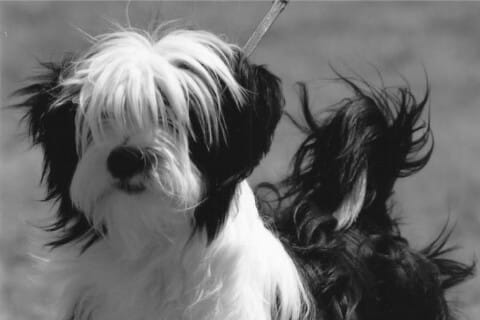Home » Meet The Breeds » Tibetan Terrier
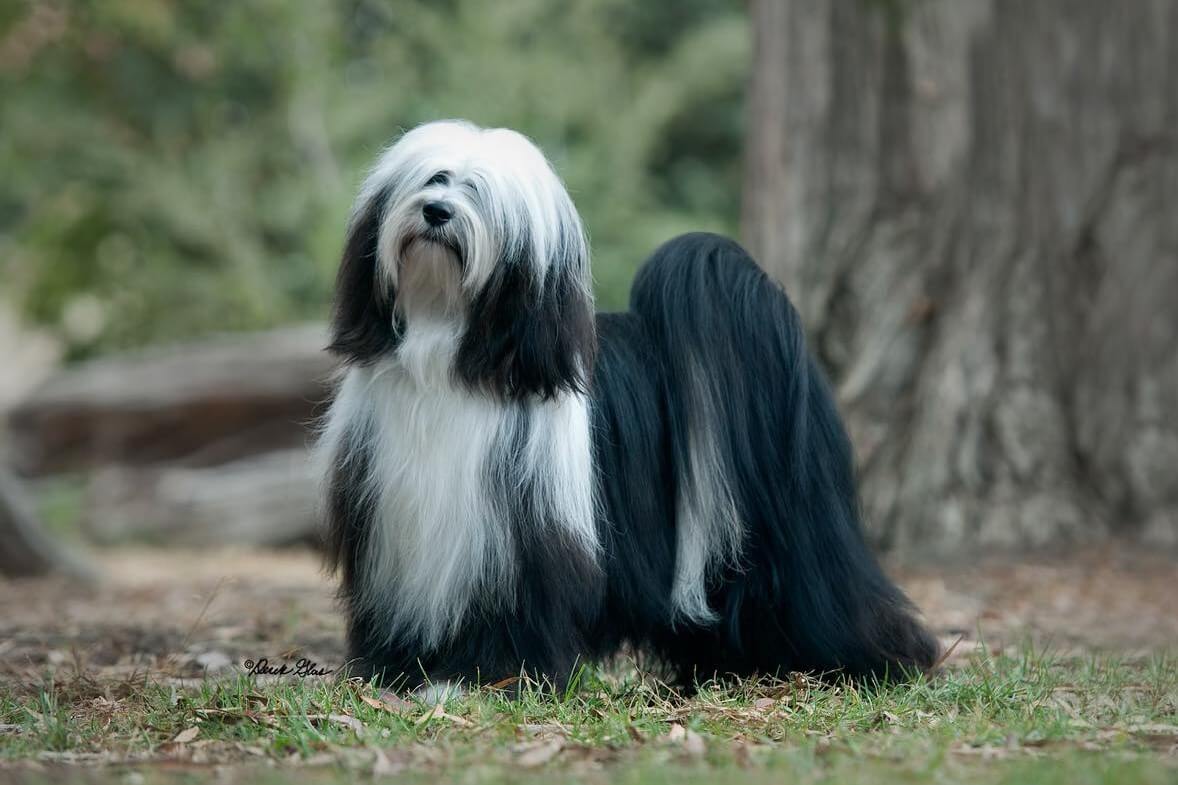
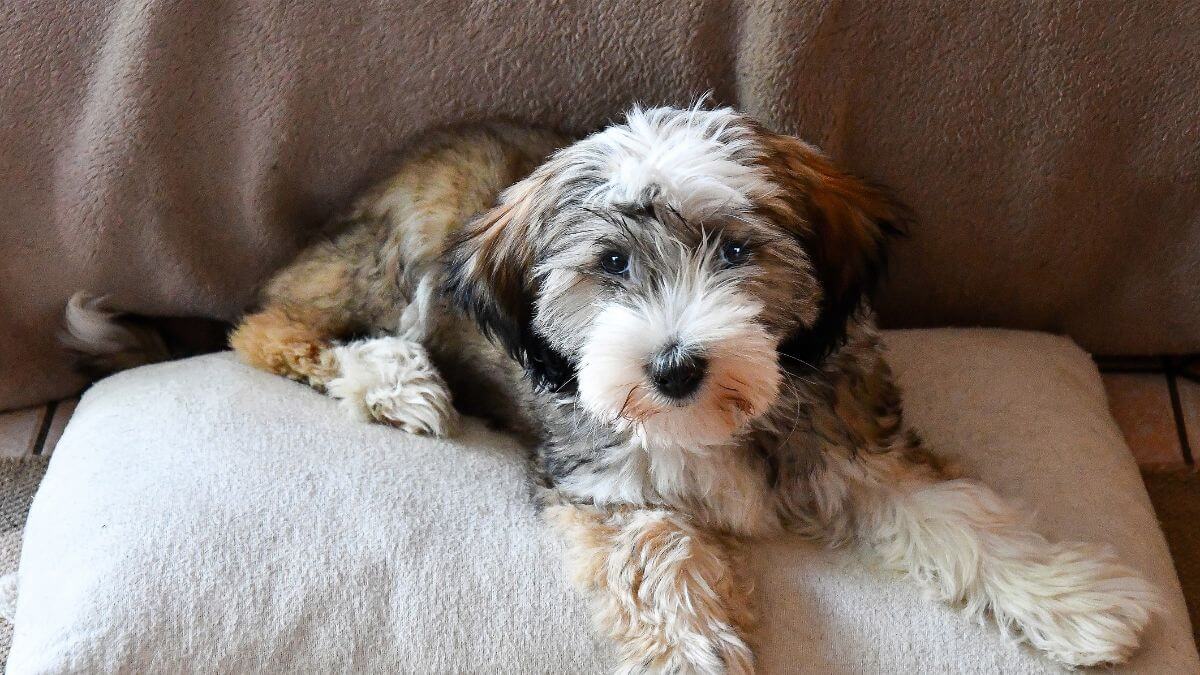
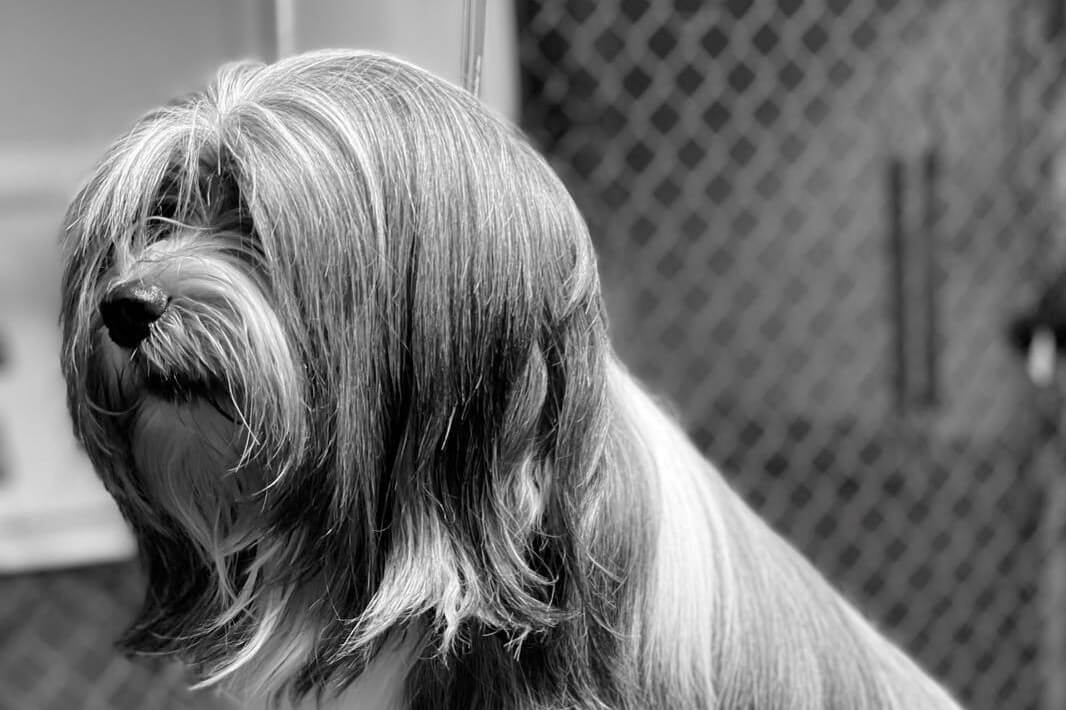
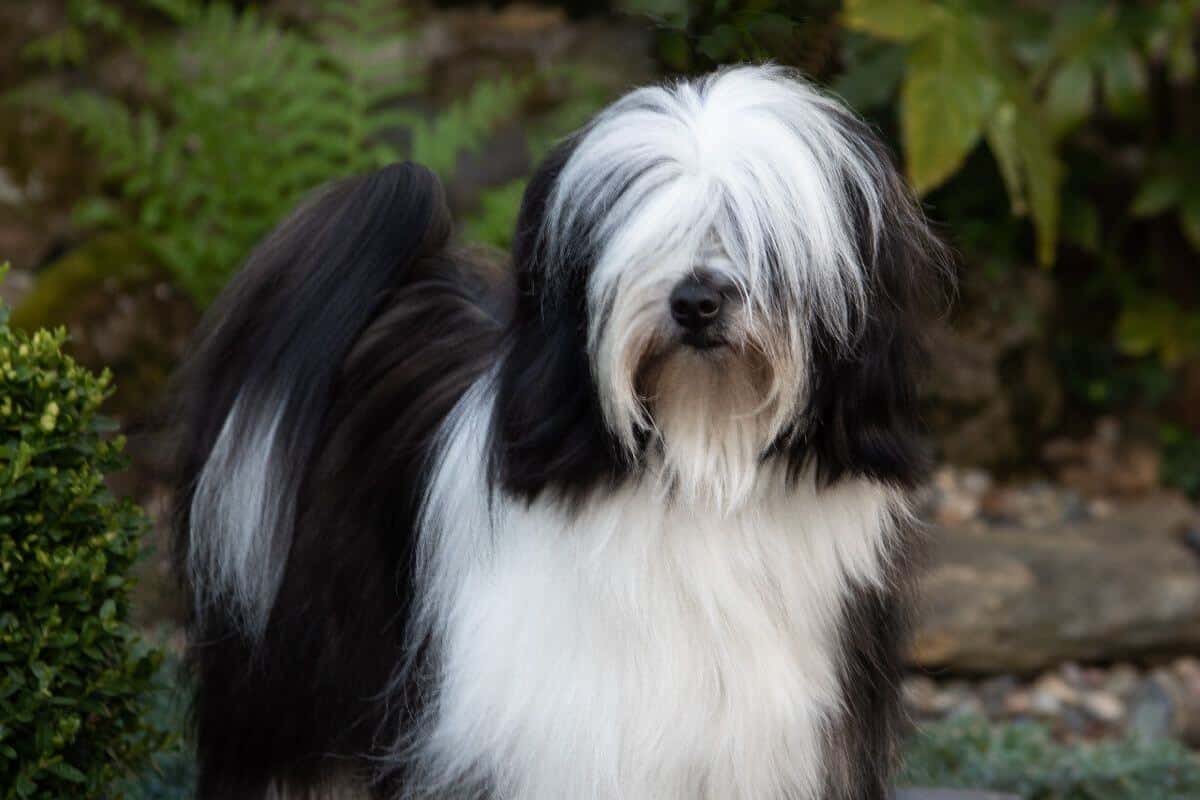
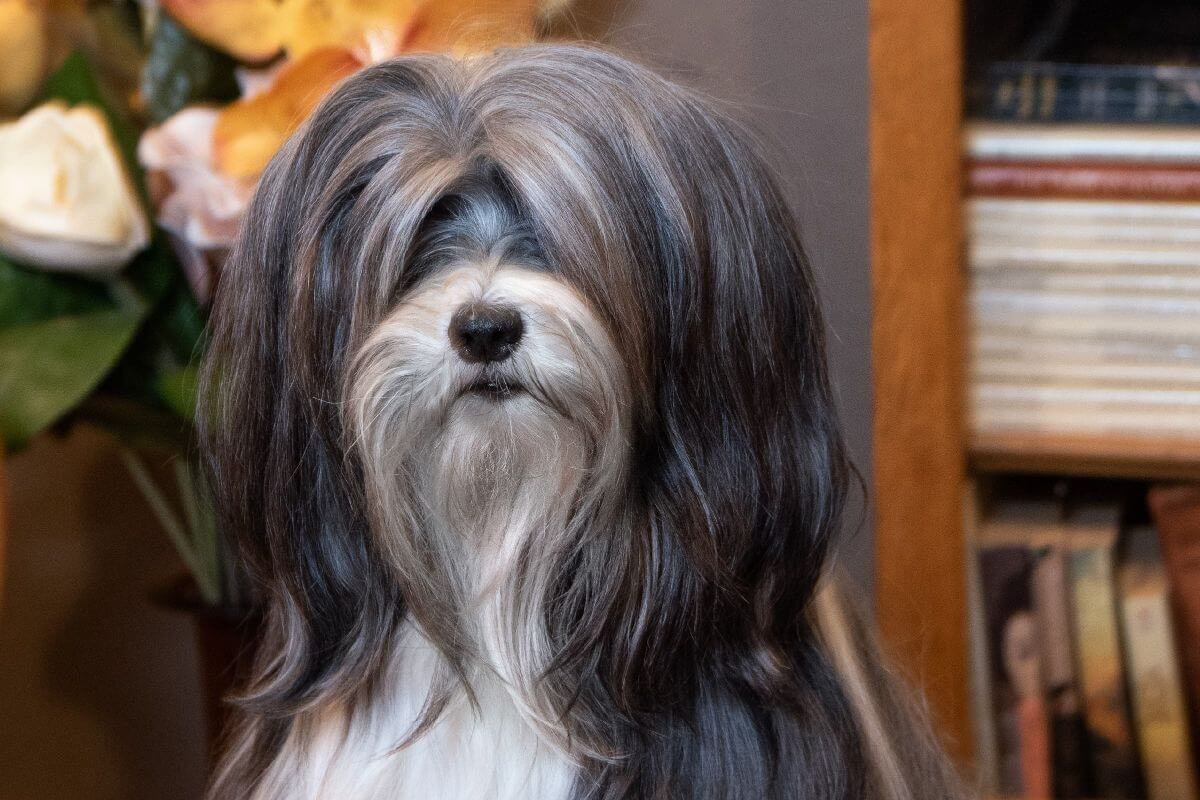
Lee Whittier
26/11/2024
Tibetan Terriers are called “little people” in Tibet, and are sometimes human-like in their discernment. The TT can be clever and even sneaky. They are discerning in relationships; your friends may or may not be their friends; however, they bond deeply to their families. In all cases, they maintain their survival instinct from the thousands of years in the extreme climate and varying altitudes of the Tibetan mountains.

Non-Sporting
14 – 17 Inches
18 – 30 Pounds
12 – 17 Years
| Country of Origin | Tibet |
|---|---|
| Bred For | Caravan Dogs, Herding, Retrieving, Alerting to Danger or Stranger, Companionship |
| Known For | Beautiful Long Double Coat, Curled Tail, Loyal Nature |
| Popularity | Low to Moderate |
| Temperament | A steadfast and devoted companion in all of his owner’s endeavors, the Tibetan Terrier is highly intelligent, sensitive, loyal, devoted, and affectionate. |
| Activities | ALL activities are possible with the Tibetan Terrier. This breed can literally do anything for its owners and friends that you can think of: Retrieving, Running, Walking, Conformation Shows, Dog Sports. TTs, however, dislike water. |
The Tibetan Terrier is the “Holy Dog of Tibet.” The breed’s history dates back over 2,000 years in the Lost Valley of Tibet in the Himalayan Mountains. It is called the Lost Valley because in the 14th Century, the access road was lost due to an earthquake.
To live in a location that has the harshest of climates and wide variations in elevation, the TT had to be versatile and rugged. They also had to be athletic and have a strong survival instinct. They were treated like children by the monks and families they lived with. They were called “the little people.” They were bred and raised for 2000 years by the monks in the monasteries.
The Tibetan Terrier was never sold. They were given as gifts to only the most important visitor and to people who performed an exceptionally kind deed. This is how the TT came to be in the outer world.
An English physician, Dr. Agnes R. H. Greig, was practicing medicine in India, just South of Tibet. In 1922, she saved a Tibetan woman’s life. With immense gratitude, Dr. Greig was gifted a Tibetan Terrier. She named the puppy Bunti.
Predictably, Dr. Greig wanted a TT to breed to her beloved Bunti, and so she started the Lamleh line of Tibetan Terriers. She moved to England and continued to breed generation after generation, proving the purity of the breed. Subsequently, in 1937, she was instrumental in getting the breed recognized by The Kennel Club (UK). The breed was officially called the Tibetan Terrier.
Of course, they are not true terriers as we know them today. We have the genetic testing to prove their purity. However, they are kin to numerous breeds from that region such as the Polish Lowland Sheepdog, the Puli, the Pumi, the Tibetan Spaniel and, of course, the Lhasa Apso and the Shih Tzu.
The Tibetan Terrier’s average height is from 15 to 16 inches, with females slightly smaller. The breed may range from 14 to 17 inches. The average weight range for both males and females is 20 to 24 pounds; with a minimum of 18 pounds and maximum of 30 pounds for both sexes.
Physically, the breed is squarely built and sturdy on an athletic frame underneath all that hair. They are capable of doing a 180-degree turn in the blink of an eye or scale a six-foot fence with equal agility.
Texture: The coat is long and double-coated; all colors are acceptable. Their profuse, double coat kept them warm in the high altitudes. As the story is told, each Spring, the locals would shear their coated pack animals, the sheep, and also the Tibetan Terriers, and create wool to make clothes and warm bedding. It is told that they would sew the children into their woolen clothes each winter to keep them warm!

| Standard Color | |
|---|---|
| Black | ee |
| Black & White | ee |
| Black White & Gold | ee |
| White & Gold | ee |
| Gold & White | ee |
| Golden Brindle | ee |
| White | ee |
| White & Black | ee |
| Sable | ee |
| Brindle | ee |
| Gold | ee |
| Black & Gold | n |
| Brown & White | n |
| Silver | n |
| Silver & Black | n |
| Silver & White | n |
| Brindle & White | n |
| Brown | n |
| Fawn | n |
| Fawn & White | n |
| Gray | n |
| Black & Brown | n |
| Black & White Brindle | n |
| Black Brown & White | n |
| Sable & White | n |
| Gray & White | n |
| Red & White | n |
| Black Brown & White | n |
| Red Brindle | n |
| Black & Brindle | n |
A Note About Color: All coat colors and combinations are acceptable. All markings are acceptable; however, note that the nose is always black.
| Standard Marking | |
|---|---|
| White Markings | ee |
| Black Markings | ee |
| Black Points | n |
| Black Mask | n |
| Ticked | n |
| Sable | n |
The tail falls forward over the back, and may curl to either side. It is set on fairly high and is profusely coated, presenting the balance of the head and tail.
Is a Tibetan Terrier right for you? Consider if the breed’s personality is in alignment with your own nature. Ask yourself what kind of time you have now, and will you have in the future, to care for a dog. Do you have the time and inclination to train a TT? Do you have the patience to work with a dog that has “creative thinking?” Are you sedentary or do you enjoy walking and hiking in all weather? Further considerations are the age of your children, whether you go off for lots of travels on weekends, and of course, whether you like to brush hair and care for the personal needs of a dog of the TT’s nature.
The Tibetan Terrier is overall a healthy breed. However, occasionally there are individuals with health problems that require extra care. Consider whether you are inclined to care for a dog, for possibly an extended period of time, that may have a health issue.
Lifespan: Happily, the TT usually lives from 12-17 years! In rare cases they may die younger from one of the potential health risks listed below.
Although there is a list of recommended tests for TTs, the breed tends to be quite healthy overall. Here are the conditions that are recommended by the Tibetan Terrier Club of America for your TT. All results should be registered with the Orthopedic Foundation for Animals (OFA). All tests are non-invasive and painless.
Congenital Deafness can include one of the following:
The Tibetan Terrier is a free spirit. These dogs are often aloof with strangers but completely devoted to family members and friends. True to their roots, they have a strong instinct to alert their loved ones to any perceived or possible intruders. Blessed with keen eyesight, they can spot anything out of place in their territory from meters, or even kilometers, away, and will instantaneously alert with their own cacophonous sound. Harkening back to their mountainous origins in Tibet, they love to perch in the highest place in the house or yard to scan everything in sight.
There is not just one right way to feed your Tibetan Terrier. For centuries, this breed lived in the Himalayan Mountains where the weather and terrain were demanding. They survived on what they were fed by the herders, villagers, and Lamas. They maintain this ability in the present day, but require a balanced diet with proper nutrition to have optimal health. Check with your breeder and veterinarian to see what’s right for your dog. Make sure to have regular checkups with your veterinarian.
So-called obedience training is an art with a TT. These dogs are usually better at training you with their wily ways than you will ever dream of being a trainer to them. They are so endearing that you will find them on your sofa in no time, regardless of any house rules you may have previously had in place with other dogs. Socialization is a must, as is positive reinforcement training. Keep on top of the behaviors that are important to your household. Teach your TT to come, sit, down, heel, and stay. These are the basics of a great relationship.
Tibetan Terriers love to run, jump, leap, and run some more. It’s best to have a secure six-foot fence, and plan to play with your dog in the yard. It’s not uncommon for a TT to scale a chain-link fence with ease. This is not a breed you can allow off-lead, or you may never see it again. Even obedience-trained dogs cannot be trusted on their own. All hikes should be on lead, whether in a state park or the wilderness.
| Energy Level | Moderate to high energy level, though they are happy to sleep at your feet while you work. They will expect some joyful interaction afterward. |
|---|---|
| Exercise Requirements | 30 Minutes/Day (Minimum), Daily Walks, Vigorous Running, Regular Exercise, Mental Stimulation |
There is a lot of grooming involved with this breed. Regular brushing, always weekly and sometimes daily, is required to maintain the coat. Depending on your personal hygienic requirements and the amount of time the dog spends outdoors, weekly to monthly bathing will be necessary. If you cannot bathe and dry the dog at home, you may need to visit a grooming shop for bathing or cutting down the coat. In this breed, matting is real! Regular trips to the groomer will be required to keep the coat short and manageable.
| Coat Type | Double, Long |
|---|---|
| Grooming Requirements | Daily brushing, until the adult coat is fully present, should be expected, though some dogs need only weekly brushing; weekly bathing, though some dogs do well with monthly baths; monthly trimming; routine ear cleaning; weekly nail trimming; regular tooth brushing. |
There is never a dull moment with a Tibetan Terrier! Although they are the Holy Dog of Tibet and referred to by Tibetans as “the little people” because of how they fit into the home like a member of the family, they can be as sneaky and mischievous as young children at times! This isn’t the breed for everyone, but it is perfect for those who live a creative and serendipitous life. People who own a Tibetan Terrier are often reclusive or artistic, perhaps entrepreneurial in nature, much like this breed. When the breed is right for someone, it’s a match for life. Sometimes, even more conventional owners find life with a Tibetan Terrier expansive and enriching, making it a match made in heaven.

Tibetan Terrier puppies are one of the most adorable breeds! They are athletic almost from the time they can walk. They are light on their feet and fly through the air with the greatest of ease. And yet, these puppies need special care to keep them safe from their own antics. They are fearless and know no boundaries. They must be taught how to respect the things that could endanger their lives. It is our job to keep them safe by watching over them with vigilance.
A word to the wise: care for your puppy as if it were a little person: love it, cuddle it, and set clear boundaries from Day One. Your puppy will require play time, rest time in a safe location like a crate, good quality food and fresh water. Keep training times short (5-10 minutes), including time to touch your dog affectionately.
Tibetan Terriers are capable of performing every sport available, with caution required around the Dock Diving option. TTs typically don’t like water, and they can hold a grudge if you force them to participate in a sport which they resent. Tap each link below to find out more.
The Tibetan Terrier is recognized by the world’s leading registries and kennel organizations, which categorize the breed into a specific Group based on its unique characteristics. This breed is recognized worldwide under the following Group designations:
| Organization | Group Designation |
|---|---|
| AKC (American Kennel Club) | Non-Sporting |
| UKC (United Kennel Club) | Companion Dog |
| CKC (Canadian Kennel Club) | Non-Sporting |
| ANKC (Australian National Kennel Council) | Non Sporting |
| RKC (The Royal Kennel Club) | Utility |
| FCI (Fédération Cynologique Internationale) | Group 9, Companion and Toy Dogs; Section 5: Tibetan Breeds |
The ideal Tibetan Terrier is described by a Breed Standard that is approved by each of the world’s leading registries and kennel organizations. The Breed Standards for this breed may be found in the following links:
| Organization | Breed Standard |
|---|---|
| American Kennel Club | AKC Tibetan Terrier Breed Standard |
| United Kennel Club | UKC Tibetan Terrier Breed Standard |
| Canadian Kennel Club | CKC Tibetan Terrier Breed Standard |
| Australian National Kennel Council | ANKC Tibetan Terrier Breed Standard |
| The Royal Kennel Club | RKC Tibetan Terrier Breed Standard |
| Fédération Cynologique Internationale | FCI Tibetan Terrier Breed Standard |

Purebred dogs are supported by breed club members who dedicate their efforts to the betterment and preservation of specific breeds. For the Tibetan Terrier, national clubs in various countries play a pivotal role in maintaining the Breed Standards, organizing events, and disseminating information to club members and potential owners alike. They are an all-in-one resource for all Tibetan Terrier fanciers.
In the United States, the Tibetan Terrier Club of America is the AKC-recognized parent club for the breed in America. Founded in 1957, the club and its members are committed to promoting responsible breeding practices, upholding the organization’s by-laws, and organizing National Specialty shows as well as other social and competitive events.
In Canada, the Tibetan Terrier Club of Canada leads in serving the breed’s needs. Similar to its American counterpart, this association is dedicated to the welfare of the breed, fostering education, and hosting events that celebrate the unique characteristics of these extraordinary dogs.
In the United Kingdom, the Tibetan Terrier Association is the breed’s parent club. Established 1967, the organization offers a platform for breeders and owners to connect and compete. It actively champions the betterment of the breed’s health and welfare with its own UK Coordinator.
Membership or affiliation with these clubs provides Tibetan Terrier enthusiasts access to a wealth of knowledge, regional and national events, and a community that shares a common love for this ancient Oriental breed.
The TTCA Rescue program attempts to find homes for Tibetan Terriers that for one reason or another could no longer stay in their previous homes. In an ideal world, there would not be any need for rescue, but in the real world there are occasionally TTs available for adoption from the club’s rescue program.
For more information you can email the TTCA Rescue team and contact a Rescue Coordinator.
Regional Coordinators:
Fran and Apple Kridakorn, Wetumpka, Alabama, serving Alabama, Georgia, Kentucky, Mississippi, and Tennessee.
Email: bowwowpublications@gmail.com
Karen Tromblee, Sun City Center, Florida, serving Florida, North Carolina, and South Carolina.
Email: https://ttca-online.org/email-to-k-tromblee/
For states not listed above, contact Camille Manfredonia
Email: https://ttca-online.org/email-to-c-manfredonia/
The Tibetan Terrier Club of Canada is dedicated to the welfare of all purebred Tibetan Terriers. Despite being a small club with members scattered across the country, the organization’s members are committed to assisting in re-homing TTs that can no longer stay in their current homes. If you have or know of a Tibetan Terrier in need of a new home, or if you are interested in adopting a rescued Tibetan Terrier, please reach out to the rescue team at nikki@tibetanterriercanada.com.
The Tibetan Terrier Association Welfare and Rescue has a UK Coordinator so that dogs who are surrendered can get to the closest point of contact as soon as possible. The TTA Welfare and Rescue provides support, rehoming services, and education for those interested in adopting “the little people.” Adopting a rescued TT is a rewarding experience, giving a loving home to a dog that truly needs it. It may take some time for the dog to settle in, but when it does, you will have a valued addition to your home.
CONTACT
Miss B P Stringer – Coordinator
Kent & South East
01474 832557
07730 921331
The Tibetan Terrier is a free spirit. These dogs are often aloof with strangers but completely devoted to family members and friends. True to their roots, they have a strong instinct to alert their loved ones to any perceived or possible intruders. Blessed with keen eyesight, they can spot anything out of place in their territory from meters, or even kilometers, away, and will instantaneously alert with their own cacophonous sound. Harkening back to their mountainous origins in Tibet, they love to perch in the highest place in the house or yard to scan everything in sight.
The Tibetan Terrier is a clean dog and is generally easy to housetrain. Like all puppies, you’ll need to keep valuables out of their reach at first. Using a crate when you can’t supervise them is advisable. Obedience training with a Tibetan Terrier is an art form. They are often more adept at training you with their clever antics than you are at training them. Their charm will quickly have them on your sofa, regardless of any house rules you may have enforced with other dogs.
Socialization and positive reinforcement training are essential. Stay on top of the behaviors that are important to your household. Fifteen minutes a day is plenty of time for practicing sit, stay, and walking on a lead. Be sure to keep the front door closed, and regularly “proof” your dog to “stay” before crossing that threshold.
The Tibetan Terrier typically wants to be with the family. Sometimes, the breed’s herding instinct will come out and they’ll want all family members to be in the same room or location. Although they have an independent streak, don’t assume your dog will be content spending hours alone while you’re at work all day or off to the beach without them. Plan on spending a good portion of your day and evening within proximity of your Tibetan Terrier.
Tibetan Terriers love to run, jump, leap, and run some more. It’s best to have a secure six-foot fence, and plan to play with your dog in the yard. It’s not uncommon for a TT to scale a chain-link fence with ease. This is not a breed you can allow off-lead, or you may never see it again. Even obedience-trained dogs cannot be trusted on their own. All hikes should be on-lead, whether in a state park or out in the wilderness. Oddly enough, with regular walks, the TT can do quite well with a small yard or even an apartment.
Homes with older children who can understand household rules and limits are the best option for the TT. Babies and young children must be supervised and never left alone with your puppy or dog. The more independent Tibetan Terrier may want its own space and may want to get away from the actions of very young household members.
The long, profuse coat of the adolescent and adult Tibetan Terrier primarily sheds within itself rather than falling out like other types of coats. However, it does shed during coat changes between age progressions and seasons. This type of shedding causes matting that may require 15-30 minutes of daily brushing.
Regular brushing, always weekly and sometimes daily, is required to maintain the coat. Depending on your personal hygienic requirements and the amount of time the dog spends outdoors, weekly to monthly bathing will be necessary. If you cannot bathe and dry the dog at home, you may need to visit a grooming shop for bathing or cutting down the coat. In this breed, matting is real! Regular trips to the groomer will be required to keep the coat short and manageable.
If you or a household member has allergies, a Tibetan Terrier may aggravate them less than other shedding dogs, but they do shed. Try testing your allergies on several occasions with at least one adult TT and at different stages of bathing. If your adult Tibetan Terrier spends a lot of time with you outdoors, grasses and pollens may stick to the coat and further aggravate your allergies.
It’s beneficial to talk to as many people as you can about the breed. Seek out insights from different breeders and owners. Attend dog shows, ask questions, and read the many books available on the breed. When you’re ready, find a reputable breeder or possibly consider contacting the Tibetan Terrier Rescue in your area. While this breed isn’t for everyone, many devoted owners believe no other breed can equal the TT. Once you have a Tibetan Terrier, you may find it hard to imagine life without one of these charming, creative companions. If you believe in soulmates, you may find yours in a Tibetan Terrier.

Ms. Lee Whittier has been involved in the sport of purebred dogs for over three decades. Her involvement began as an owner, exhibitor and, subsequently, a breeder of Rottweilers. She has owned Akitas, Bullmastiffs, and a Sussex Spaniel. She currently owns, breeds, and exhibits Tibetan Terriers. Ms. Whittier began judging in 2000, and then took a hiatus for several years to work for the American Kennel Club as an Executive Field Representative in the Pacific Northwest. She returned to judging in 2011, and currently judges the Working, Terrier, Toy, and Non-Sporting Groups, seventeen Hound Breeds, ten Sporting Breeds, Bouvier des Flandres, and Best in Show. Ms. Whittier has judged dog shows around the world, from the United States, Canada, South America, and Asia, at shows large and small; all of great importance to each and every exhibitor. Some of the larger shows are Westminster Kennel Club, Kennel Club of Philadelphia, Del Valle Dog Club of Livermore, Great Western Terrier Association, Northern California Terrier Association, Hatboro Dog Club, Inc., Malibu Kennel Club, and the Kennel Club of Palm Springs. Ms. Whittier is a standing member of Dog Fanciers of Oregon, The Central Florida Cairn Terrier Club, Columbia River Cairn Terrier Association, and the Tibetan Terrier Club of America. As an active member in numerous clubs, she has worked in the capacity of Show Chair, President, Vice-President, Secretary, Board Member, and Constitution & By-Laws Revision Committee Member. In addition to judging, Ms. Whittier developed the Dog Show Mentor program, exclusively for owner handlers. This is an online program where owner handlers of all stages and levels learn to develop an individual, strategic approach to showing dogs. She also travels to speak to owner handlers all over the world. She currently lives in Vancouver, Washington, with her husband, Wayne, and their three Tibetan Terriers. Her other interests include gardening and hiking with the dogs.
The best way to ensure a long and happy relationship with a purebred dog is to purchase one from a responsible breeder. Not sure where to begin?
Contact the National Parent Club’s Breeder Referral Program, which is listed on the AKC Breeder Referral Contacts page.
